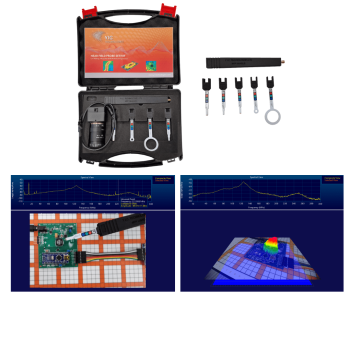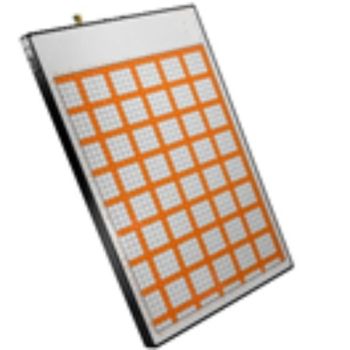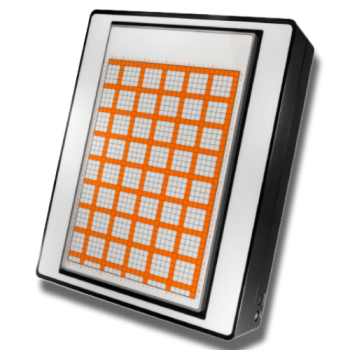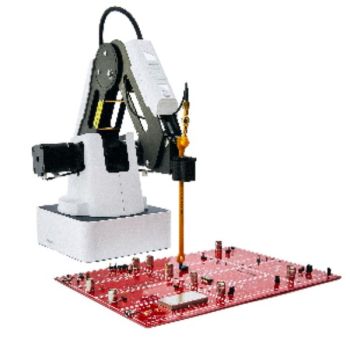Products
" An RF Probe Kit on Steroids"
- Fully integrated with Y.I.C. Technologies EMViewer software and EMProbe
- Normalization and correction when using the EMViewer software
- Flat response within the range of operation
- Slim Design and Protective Coating
- 18GHz Measured Cable included
- Lectures & Explanation Document
- Designed By Prof. Arturo Mediano, University of Zaragoza, Spain
- Capability:
- Spectral scan, spatial scan, peak-hold, continuous scanning, spectral and spatial comparison, scripting, limit lines, and report generation.
- Spatial scan time:
- Continuous real-time or sub-second single scan for the entire scan area is dependent on spectrum analyzer performance.
- Spectral scan time:
- 45 seconds for L 10 cm x W 10 cm (L 4” x W 4”) PCB with a 100 MHz span and 100 kHz RBW. Scanning area, span, and RBW are user-selectable within spectrum analyzer specifications
- EMViewer Software
- We recommend you use the EMViewer software for best results. A Yearly subscription or a once-off purchase is available.
- Supported operating systems: Windows 10®
- Supported CAD overlays: Standard Gerber© RS274x format and HPGL format
- Capability:
-
- Spectral scan, spatial scan, peak-hold, continuous scanning, spectral and spatial comparison, scripting, limit lines, report generation, and notes.
- Spatial scan time:
-
- Continuous real-time for the entire scan area (1,218 probes activated) when Level 1 is selected: 5 sec.
- Selected area 2.25 cm x 2.25 cm, 9 probes activated.
- Level 1:
- Spectral scan time:
-
- 11 seconds for L 10 cm x W 10 cm (L 4” x W 4”, 178 probes activated) from 10 MHz span to 110 MHz and 122 kHz RBW. Scanning area, span, and RBW are user-selectable within spectrum analyzer specifications
- Supported operating systems: Windows 10®
- Supported overlays: Picture in JPEG format
- Standard Gerber© RS274x format and HPGL form
- Capability:
- Spectral scan, spatial scan, peak-hold, continuous scanning, spectral and spatial comparison, scripting, limit lines, report generation, and notes.
- Customization of the robot arm size, any size, is possible.
- Spatial scan time:
-
- The scan time depends on size and area
- Ideal for large component boards
- The robotic arm allows for advanced scans on complex items
- Supported operating systems: Windows 10®
- Supported overlays: Picture in JPEG format
- Standard Gerber© RS274x format and HPGL form
" A Probe Kit on Steroids"
- Fully integrated with Y.I.C. Technologies EMViewer software and EMProbe
- Normalization and correction when using the EMViewer software
- Flat response within the range of operation
- Slim Design and Protective Coating
- 18GHz Measured Cable included
The H20, H10, H5, and E5 are magnetic field (H) and electric field (E) probes for radiated emissions EMC pre-compliance measurements. The probes are used in the near field of sources of electromagnetic radiation. They serve to locate and identify potential sources of interference within the building blocks of electronic assemblies. The probes act similar to wide bandwidth antennas, picking up radiated emissions from components, PCB traces, housing openings or gaps and from any other parts that could be emitting RF. The probes are usually connected to a spectrum analyzer. Scanning the probe over the surface of a PCB assembly or housing quickly identifies locations which emit electromagnetic radiation. By changing to a probe with a smaller size, the origination of the emissions can be further narrowed down. With TBWA2 WIDEBAND AMPLIFIER/40DB
The H20, H10, H5, and E5 are magnetic field (H) and electric field (E) probes for radiated emissions EMC pre-compliance measurements. The probes are used in the near field of sources of electromagnetic radiation. They serve to locate and identify potential sources of interference within the building blocks of electronic assemblies. The probes act similar to wide bandwidth antennas, picking up radiated emissions from components, PCB traces, housing openings or gaps and from any other parts that could be emitting RF. The probes are usually connected to a spectrum analyzer. Scanning the probe over the surface of a PCB assembly or housing quickly identifies locations which emit electromagnetic radiation. By changing to a probe with a smaller size, the origination of the emissions can be further narrowed down. With TBWA2 WIDEBAND AMPLIFIER/20DB
The H20, H10, H5, and E5 are magnetic field (H) and electric field (E) probes for radiated emissions EMC pre-compliance measurements. The probes are used in the near field of sources of electromagnetic radiation. They serve to locate and identify potential sources of interference within the building blocks of electronic assemblies. The probes act similar to wide bandwidth antennas, picking up radiated emissions from components, PCB traces, housing openings or gaps, and from any other parts that could be emitting RF. The probes are usually connected to a spectrum analyzer. Scanning the probe over the surface of a PCB assembly or housing quickly identifies locations that emit electromagnetic radiation. By changing to a probe with a smaller size, the origination of the emissions can be further narrowed down.







